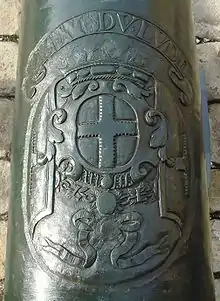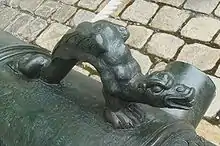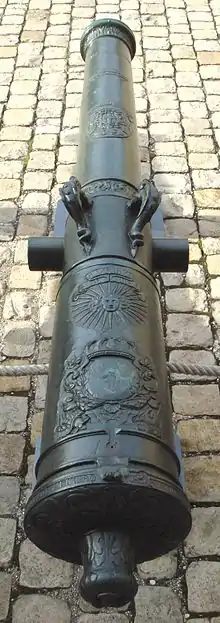Jean-Jacques Keller
Jean-Jacques Keller (1635–1700) and his brother Jean-Balthazar Keller (1638–1702) were Swiss gunfounders from Zürich, in the service of France.
_orf%C3%A8vre_et_fondeur.jpg.webp)



Jean-Jacques was considered as one of the most skillful founders of France.[1] In 1669, he became "Master of the foundries" (Commissaire des Fontes) at Douai. He also established other foundries in Besançon, Breisach and Pinerolo.[2] His work was integral part of the plan established by Louvois in 1666 to have the army and artillery reorganized.

His brother Jean-Balthasar was rather involved with the founding of statues.[2] He famously founded the statue of Louis XIV then located in the Place Vendôme, in December 1692,[3] in a single piece, something never achieved before.[2] The statue was destroyed during the French Revolution on 10 August 1792.[4]
Jean-Jacques met with trouble when some of his guns burst in 1694. He was then replaced by his brother Jean-Balthasar as Commissaire des Fontes at Douai.[2]
The two brothers had a great influence on cannon founding techniques in France, and made thousands of artillery pieces.
The technology they employed, involving the founding of cannons around a plaster core, was superseded by the De Vallière system in 1732.
See also
![]() Media related to Jean-Jacques Keller at Wikimedia Commons
Media related to Jean-Jacques Keller at Wikimedia Commons
Notes
- "Jean- Jacques Keller, his older brother, the most skillful cannon founder in the service of France" in One Hundred Years at V.M.I. - Page 263 by William Couper -
- Gunfounding and Gunfounders by Arthur Norris Kennard, p.96-97
- The History of Paris, from the Earliest Period to the Present p.27
- Galignani's New Paris Guide By A. and W. Galignani p.193
Gallery
 Keller 12-pounder Le Solide. Caliber: 121 mm. Length: 310 cm. Weight: 1,586 kg. 1688.
Keller 12-pounder Le Solide. Caliber: 121 mm. Length: 310 cm. Weight: 1,586 kg. 1688. Keller 16-pounder Le Combattant. Caliber: 134 mm. Length: 310 cm. Weight: 2,369 kg. 1674
Keller 16-pounder Le Combattant. Caliber: 134 mm. Length: 310 cm. Weight: 2,369 kg. 1674 Keller 16-pounder La Curiosité. Caliber: 134 mm. Length: 310 cm. Weight: 1,968 kg. 1679
Keller 16-pounder La Curiosité. Caliber: 134 mm. Length: 310 cm. Weight: 1,968 kg. 1679